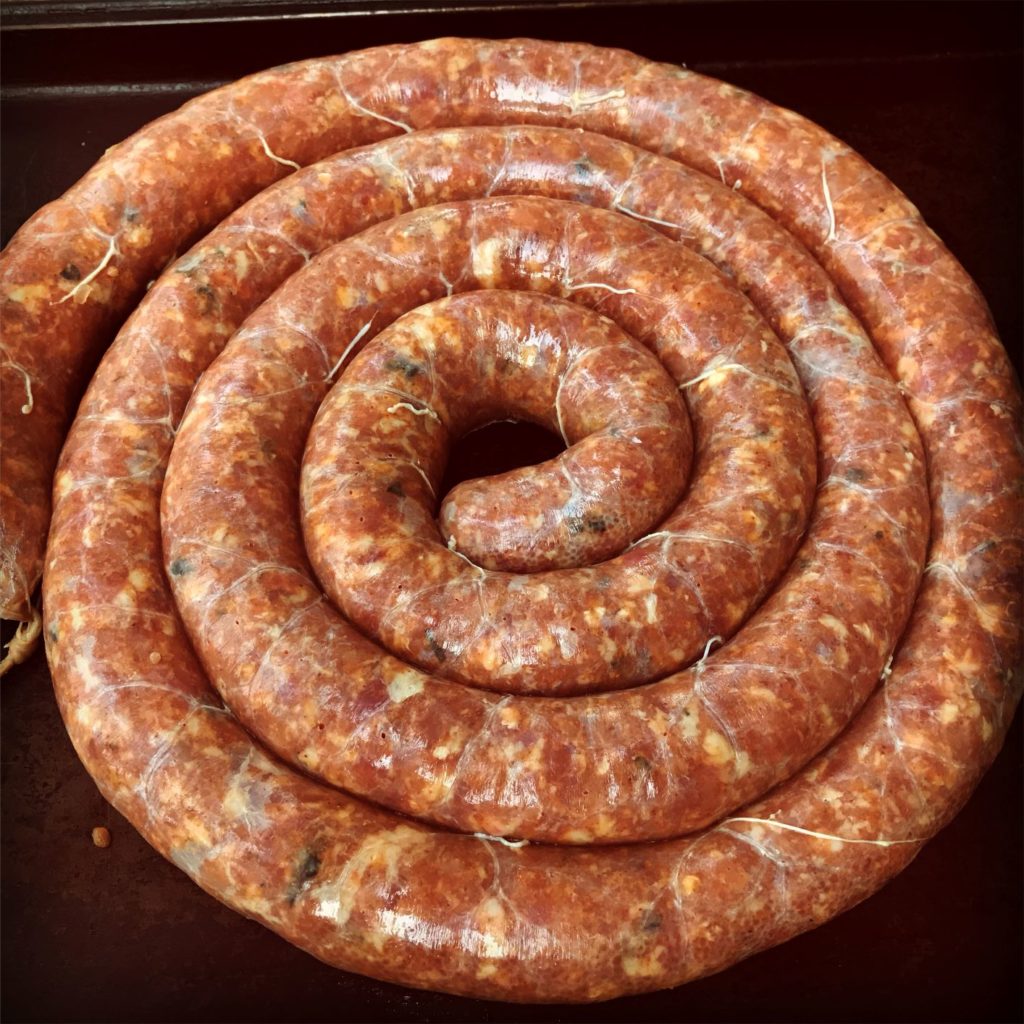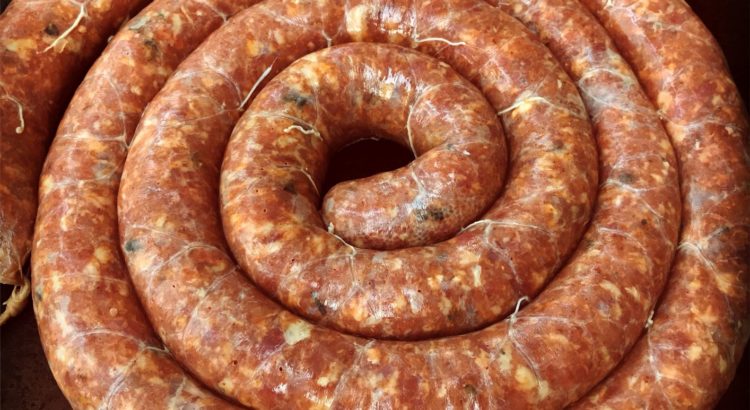
It took me about a year to get all the gear, source the pork and casings then carve out enough time – A weekend here and there – to really get into fresh sausage making. Now I’ve done over a dozen batches and experimented with many different recipes and techniques and I think I’m almost to the point where I now know exactly how much I don’t actually know. *Laughs*
So before I start throwing up my beginner-friendly go-to recipes I figured I’d share a couple of observations that this year of grinding and stuffing has taught me and might help another novice de-stress and avoid some expensive pitfalls. This is all pretty basic stuff and anyone who is already deep into the world of charcuterie or salumi will not find any secret wisdom herein. Also, to clarify this is entirely for “fresh” sausage making, I have yet to smoke, air dry or ferment anything I’ve stuffed… I haven’t got that kind of time or space.
I’ll try and update this list as my journey progresses and I learn more. Stick around for the credits where I will list any sausage recipes I’ve got in my back pocket.
Observation #1 – Everything Related to Sausage Making is a Metaphor for Sex
Butchery and meat processing may be an ancient and noble tradition, but it’s practitioners are famous for the amount of crude entendre they throw into their daily toil. And it’s damn easy: grinding, stuffing, pricking and every other adjective relating to tube meat is a dirty word to someone and should be said with just enough of a wink and giggle that everyone has a laugh. Remember what Anthony Bourdain said, “I have since found that almost everybody in the meat business is funny —just as almost everyone in the fish business is not.”
Observation #2 – You Have To Plan Your Day
It takes me an average of 3-4 hours to bang out 50-60 sausages start to finish. This is at a pretty even pace and is dependant on having everything washed, assembled and ready to go when it comes time to use it. That’s a substantial chunk of my day off and doesn’t even take into account the hour spent washing all the dishes or packaging up the finished product. So it’s no good starting at 5:30pm and rushing to get everything squared away for dinner, especially when the last few steps take such concentration and care.
Observation #3 – Get Your Gear and Source Your Sausage Meat
Sausage making takes either a lot of specialized equipment of a lot of sweat and additional time. Now, I didn’t go out and buy the most expensive of everything, I still need to turn a hand crank for practically everything. A quality mid-range set of gear is perfect for a novice like me. Check out my wish list from a couple Christmas’s ago to get an idea of what you’ll need to get stuffing.
The same philosophy does not apply to the meat that will eventually end up in you and your family’s stomachs. Don’t skimp, buy the best meat you can from a farmer if possible and if they sell pig’s guts as casings that’s a bonus! Never, ever buy synthetic casings.
Observation #4 – Pork Shoulders and the Golden Ratio
Charcuterie legend John Van Der Liek was the one who taught me the golden ratios of 90-70% Meat to 10-30% Fat that I’ve used in every preparation of sausage. It just so happens that this balance occurs naturally in the pigs shoulder extending down it’s leg. This hunk of meat can be purchased very cheaply as just the “shoulder”, “butt” or if left with the leg bit called a “picnic”. As mentioned above, try to get the best you can!
Observation #5 – Salt and Seasoning
For every Kg of meat the sausage mix requires about 20g of salt. The seasonings that follow can be anything from paprika and ancho (chorizo) to marjoram (kelbasa) to caraway and white pepper (morteau) bound together with a variety of fillings, liquids and even blood! Seasonings should be ground with the meat to ensure even distribution.
Observation #6 – Temperature Control
Pork fat melts when it is heated, this can cause uneven distribution within the sausage filling and will lead to dry or overly-greasy sausages sometimes within the same batch. To avoid any rendering during the grinding, mixing and stuffing phases it is essential to keep everything very cold. Keep your meat in the fridge right up until the last second and grind it into a bowl set in ice. Freeze your metal attachments before use. Use plastic stuffing attachments to avoid heat buildup between metal parts. If things feel like they are getting warm pop them back in the fridge for half an hour.
Observation #7 – The Magical Primary Bind
Running your mixer’s paddle attachment through even the coarsest of sausage mixes suddenly brings it all together in that shiny, sticky, magical and slightly glutenous texture necessary for the stuffing stage. Add in a bit of ice cold liquid and it gets even silkier. Add wine and it becomes a masterpeice.
Observation #8 – Always Sneak a Taste Before You Stuff
Fire up a small frying pan and sear off a small disk of your sausage mix to make sure the texture, salt ‘n seasoning levels are just right. This is the easiest thing to forget, yet it could save you a whole batch of sausage if the taste isn’t just right.
Observation #9 – Easy Does It
Once the meat filling is in the hopper and the sausage starts ‘a flowing it can start to seem a little hectic… Relax! It’s your day off! Slow that hand crank and just take it one link at a time. There is no reason to rush right at the end when any bit of excess pressure could cause your sausages to burst. This is why you planned out your day, remember? Besides, this is fun! Sausage making is a hobby, treat it as such and enjoy your time with it.
Observation #10 – I Hope Your Friends Like Sausage
Every pork shoulder I put through the grinder can make about 30 hefty sausages. That is a lot of tube meat and I do not have much space left in the freezer, so my wife pulls out the vacuum sealer and we start packaging bratz for all of our friends and family. Winter sausages inevitably end up as Christmas gifts and have become a bit of a tradition. Sure beats the hell out of some socks.

Hi,good write up I love it but my biggest problem is always the same. I would any like any guidence you can offer on how to position the casing, do you leave it on the tube and and push your mixture down the tube and this way the casing comes of the tube but this way it all full of salt.So take the casing off the tube clean off the salt inside and out now starts the prob getting the casing over the funnel as it tends to close up and to get it open to fit it over the funnel near impossible
Hi Howard.
First off, I’m not sure what you mean by “salt” as the salt is already mixed into the meat equally during grinding. The casings get thoroughly rinsed before stuffing so there isn’t any salt there either. I’m not sure where this excess salt is coming from?
Stuffing is a bit of an art which I don’t pretend to completely understand, but I’ve got a couple tricks that work well.
I’ll take a couple feet of casing and carefully roll it up over the funnel, link after link until it resembles a discarded sock. I keep the other end open until I’ve cranked the meat right to the point where it’s poking out the end of the funnel. To avoid bubbles I tie off the casings right at this point and give it a careful poke with my handy sausage pricker before starting to crank out the sausage. Usually this makes for a mostly normal-looing first link of sausage, but I always consider the first bit a right-off! *laughs*
I hope this helps. Let me know if it does!
Cheers.
I stuff my fresh Polish sausage by hand…..any suggestions to make it easier? Also, the only seasonings I use are garlic, salt, freshly ground pepper and MUSTARD SEEDS! I have been the only one in my family that stuffs sausage and I’m 77 yrs old so I’ve been doing it for a long time…..the sausage horn has been passed down in the family.. Mynproblem is getting casings!
Hi Suzi.
Thank you so much for sharing your recipe! I love the addition of mustard seed, and the fact your using an heirloom horn makes the whole process so magical! Stuffing by hand can get quite taxing over time so I’ve switched to a crank-fed stuffer which makes the whole process go a lot faster. Casings can be tough, I usually look for supermarkets or butchers that feature homemade sausage and just ask them if they’d sell me some. It usually works!
how to get ” snappy” brats, not ang, ang, ang, chewy casings?
First off, awesome descriptor: “Ang, ang, ang” is perfect! I’ve had really good luck with hog casings purchased from my local butcher. The ones who have spent the least amount of time in salt seem to be a little less chewy, but sometimes a little more “meaty” in smell. Really snappy!